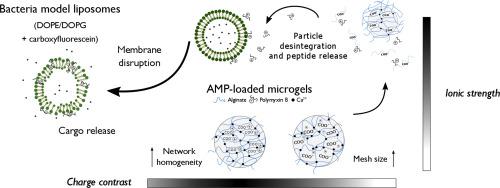Biochimica et Biophysica Acta (BBA) - General Subjects ( IF 3 ) Pub Date : 2019-11-15 , DOI: 10.1016/j.bbagen.2019.129485 Bruno C Borro 1 , Marie S Toussaint 2 , Saskia Bucciarelli 3 , Martin Malmsten 4

|
Microgels offer opportunities for improved delivery of antimicrobial peptides (AMP). To contribute to a foundation for rational design of such systems, we here study the effects of electrostatics on the generation of peptide-carrying microgels. For this, alginate microgels loaded with polymyxin B and cross-linked by Ca2+, were formed by electrostatic complexation using a hydrodynamic focusing three-dimensional (3D)-printed micromixer, varying pH and component concentrations. The structure of the resulting composite nanoparticles was investigated by small-angle X-ray scattering, dynamic light scattering, and z-potential measurements, whereas peptide encapsulation and release was monitored spectrophotometrically. Furthermore, membrane interactions of these systems were assessed by dye leakage assays in model lipid vesicles. Our results indicate that charge contrast between polymyxin B and alginate during microgel formation affects particle size and network dimensions. In particular, while microgels prepared at maximum polymyxin B-alginate charge contrast at pH 5 and 7.4 are characterized by sharp interfaces, those formed at pH 9 are characterized by a more diffuse core, likely caused by a weaker peptide-polymer affinity, and a shell dominated by alginate that shrinks at high CaCl2 concentrations. Quantitatively, however, these effects were relatively minor, as were differences in peptide encapsulation efficiency and electrolyte-induced peptide release. This demonstrates that rather wide charge contrasts allow efficient complexation and particle formation, with polymyxin B encapsulated within the particle interior at low ionic strength, but released at high electrolyte concentration. As a consequence of this, peptide-mediated membrane destabilization were suppressed by microgel incorporation at low ionic strength, but regained after microgel disruption. After particle disruption at high ionic strength, however, some polymyxin B was found to remain bound to alginate chains from the disrupted composite microgel particles, resulting in partial loss in membrane interactions, compared to the free peptide.
中文翻译:

电荷对比度和组成对微凝胶形成和与细菌模拟脂质体相互作用的影响
微凝胶提供了改善抗菌肽(AMP)递送的机会。为了为此类系统的合理设计奠定基础,我们在这里研究静电对载肽微凝胶产生的影响。为此,藻酸盐微凝胶载有多粘菌素B并通过Ca 2+交联通过使用流体动力聚焦三维(3D)打印的微型混合器通过静电络合形成pH值和组分浓度变化而形成。通过小角度X射线散射,动态光散射和z电位测量研究了所得复合纳米颗粒的结构,而肽的包封和释放则通过分光光度法进行了监测。此外,通过模型脂质囊泡中的染料渗漏试验评估了这些系统的膜相互作用。我们的结果表明,在微凝胶形成过程中,多粘菌素B和藻酸盐之间的电荷对比会影响粒径和网络尺寸。尤其要注意的是,在pH值为5和7.4时,以最大的多粘菌素B-藻酸盐电荷对比制备的微凝胶的特征是清晰的界面,2个浓度。然而,定量地,这些影响相对较小,肽包封效率和电解质诱导的肽释放的差异也较小。这表明相当宽的电荷反差允许有效的络合和颗粒形成,其中多粘菌素B以低离子强度封装在颗粒内部,但以高电解质浓度释放。结果,在低离子强度下通过微凝胶掺入抑制了肽介导的膜失稳,但在微凝胶破裂后又恢复了。然而,在高离子强度的粒子破坏后,发现一些多粘菌素B仍然与破坏的复合微凝胶粒子的藻酸盐链结合,与游离肽相比,导致膜相互作用的部分损失。



























 京公网安备 11010802027423号
京公网安备 11010802027423号